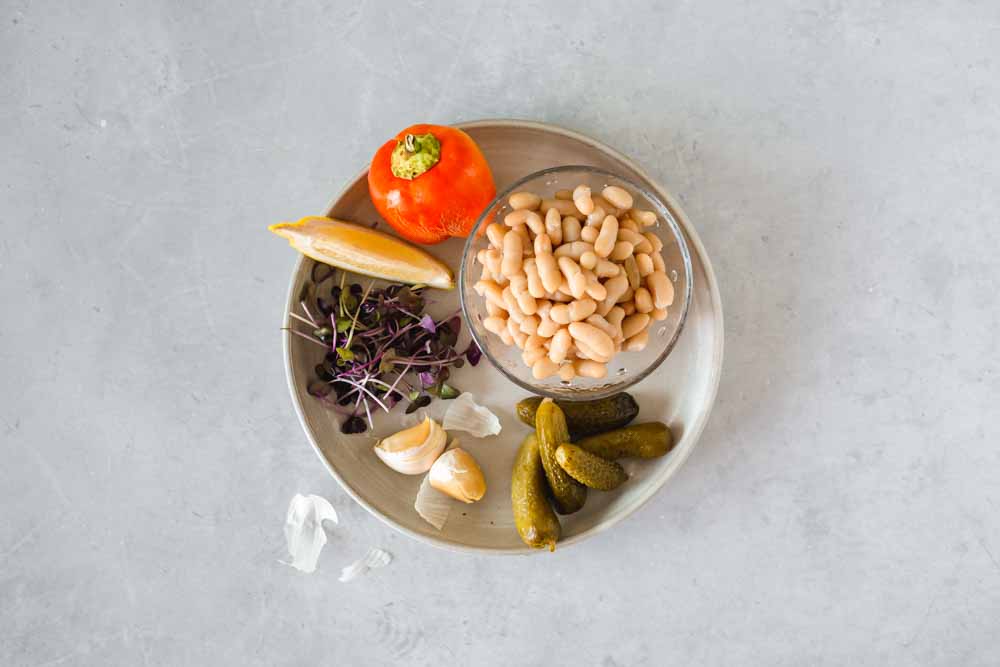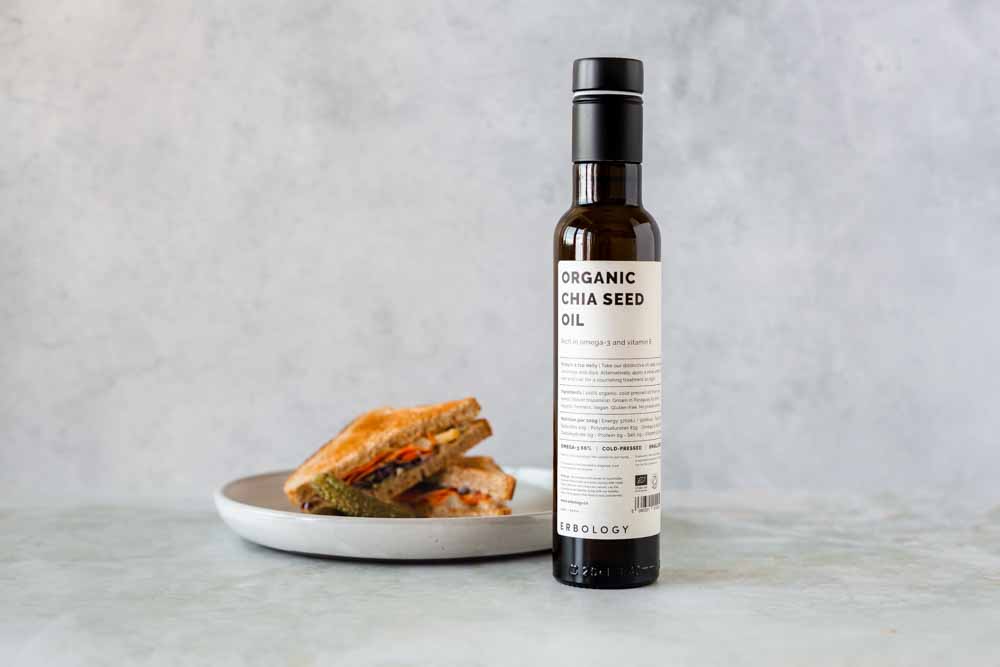White bean and veggie sandwich
- 2
Serving

Prep Time 10'

Total Time 15'

Easy

Vegan
- 2
Serving

Prep Time 10'

Total Time 15'

Easy

Vegan
The history of the humble sandwich
At its core, the sandwich is simple. Two pieces of bread, with some kind of filling between them. This also means it’s an extremely versatile dish. You can use any type of bread you like, and put anything you want between the slices! So it’s no surprise that sarnies are such a popular lunch option. But where and when did the humble sandwich originate?
As you probably expect, it’s impossible to say exactly when people first began eating bread with fillings. Scientists have discovered evidence of bread-making that dates back an astonishing 14,000 years.(1) What’s more, experts theorise that prehistoric humans may have wrapped roasted meat inside this bread. In which case, the sandwich might very well be a stone age invention!
Of course, people didn’t use the word ‘sandwich’ for this type of food until much later. That name comes from the fourth Earl of Sandwich, John Montagu.
The most popular story claims he was playing cards with friends and wanted to continue doing so as he ate. So, he asked for “a bit of beef, between two slices of toasted bread”.(2) Others say that, as Lord of the Admiralty, it’s more likely he created the dish so that he could eat while working at his desk. A trend that persists for many office staff who bring a veggie sandwich to work!
Either way, the name stuck, and over time the popularity of the sandwich grew exponentially. When Marks and Spencer introduced the first pre-packaged sandwich in 1980, it solidified the food’s place as a handy lunch option.(2) However, although they’re convenient, making your own sarnie is generally healthier and more environmentally friendly.(3)
With that in mind, let’s find out how this veggie sandwich could support your wellbeing.
The wonderful health benefits of white beans
No one wants a sandwich that’s too dry. And while spreads like margarine and peanut butter function perfectly well, we’re using white bean purée on this veggie sandwich. There are several varieties of white beans to choose from, including cannellini beans, butter beans, and haricot beans. But whichever you pick, they offer a wealth of potential health benefits.
For starters, beans are a fantastic source of plant-based protein. This makes adding beans to veggie sandwich recipes particularly beneficial for those on a vegetarian or vegan diet. Protein is vital for many of the body’s functions, including building muscle, maintaining bone health, and repairing damaged tissue.
White beans are also bursting with fibre, which supports a healthy digestive system. It acts as a prebiotic, nourishing the good bacteria in your gut. This is important because the gut microbiome influences everything from brain function to immunity. Fibre can additionally promote heart health by lowering blood pressure and improving cholesterol levels.
This combination of high fibre and high protein also promotes feelings of fullness, making it easier for you to maintain a healthy body weight. Indeed, studies show that people who regularly consume beans are less likely to be obese or have excess belly fat.(4)
Finally, white beans are rich in numerous key vitamins and minerals. These include copper, folate, iron, phosphorus, zinc, potassium, and magnesium. These all have crucial roles to play in keeping us healthy and happy.
Interestingly, studies show that beans are a central part of the daily diet in all the Blue Zones.(5) These are locations around the world where residents enjoy exceptional longevity. That alone is an excellent reason to add them to your veggie sandwich!

Eat your veggies!
It goes without saying that vegetables are beneficial for our health and wellbeing. And while we all know this, it’s worth briefly going over exactly why. The details are sure to encourage you to pack as many into your veggie sandwich as possible!
Numerous studies have found that a diet rich in fruit and veg can lower your risk of several harmful conditions.(6) These include heart disease, stroke, diabetes, obesity, and even cancer. This is partly because fruits and vegetables are high in fibre, along with plenty of important vitamins and minerals. Fruits and vegetables also help to protect your vision thanks to certain carotenoids they contain, like lutein and zeaxanthin.
Moreover, many of the compounds in vegetables act as antioxidants, defending our cells against the damage caused by free radicals. In addition, they help to reduce inflammation, further lowering the risk of chronic disease.
Each type of vegetable has its own wellness-boosting plant compounds, so variety really is the spice of life here. Try to tuck into a range of different-coloured veggies to maximise the health benefits you get from your diet. In addition, it’s best to avoid cooking your vegetables too much, as this can decrease their nutrient content.
Who would have thought that a veggie sandwich could have such a positive impact on our health? So without further ado, let’s look at how to whip up this white bean and vegetable sarnie.
Simple yet scrumptious and satisfying: our veggie sandwich recipe
We’re sure you know how to make a veggie sandwich! However, if you want to create this particular one, here’s how.
We’ll begin by making the white bean paste for the veggie sandwich. First, pop one and a half cups of your chosen variety of white beans into a blender. Then sprinkle in a pinch of sea salt, along with the sweet paprika and dried oregano. To this, add half a clove of garlic, a splash of lemon juice, and a drizzle of chia seed oil. Feel free to adjust the amount of each seasoning you use to suit your palate.
Top the mixture up with three or four tablespoons of water and blend until smooth and creamy. Try not to make it too runny, or the bread in your veggie sandwich will get soggy! Conversely, if it’s too thick, you can always add a drop more water and blend it again.
Stir in the pickled cucumber, and then spread your white bean paste on both slices of bread. We’ve recommended using wholegrain bread, but other types like sourdough and rye also work brilliantly. If you have more time, you could even bake your own!
Add the slices of pepper to one piece of bread, followed by the strips of carrot and your favourite microgreens. Pop the other slice of bread on top and press down gently to ensure the veggie sandwich stays together. Then cut your sarnie in half and enjoy! Alternatively, if you want to take your veggie sandwich into work for lunch, store it in an airtight container until you’re ready to eat.
Tasty and nutritious: the health benefits of chia seed oil
The splash of chia seed oil in the white bean paste brings a delicate nutty flavour to your veggie sandwich. But as you know, we like our ingredients to do more than just taste good. We also like them to enhance your wellbeing. And chia seed oil definitely earns its place in that regard.
Chia seed oil is naturally rich in alpha-linolenic acid (ALA), which is a form of omega-3, as well as omega-6. These healthy fats offer us a wealth of potential benefits. For example, research indicates that ALA can reduce the risk of heart disease.(7) This may be because omega-3 fatty acids help to improve cholesterol levels, lower blood pressure, and decrease inflammation.
What’s more, chia seed oil’s omega-3 content could make this the best veggie sandwich for brain health. Studies have found that ALA has neuroprotective effects, reducing the risk of conditions like stroke and Alzheimer’s disease.(8) Omega-3 fatty acids may even help to protect against depression.
Chia seed oil is also rich in vitamin E, which acts as a potent antioxidant. This means it could guard against oxidative stress, which experts link to numerous harmful health conditions. These include diabetes, heart disease, neurodegenerative diseases, and cancer. Combined with the beans and vegetables, that makes this veggie sandwich a fabulous option for a wellness-boosting lunch.
The vitamin E and healthy fats in chia seed oil might also enhance the condition of your skin. They help to hydrate the skin and reduce signs of ageing, for a more youthful and glowing complexion. Similarly, chia seed oil could keep your hair shiny and hydrated, reducing frizz and breakage. For these benefits, applying the oil externally is more effective than consuming it in your veggie sandwich.
Check out our organic chia seed oil
We craft our organic chia seed oil using raw chia seeds grown sustainably on independent farms in Latin America. After five months of cultivation, the farmers harvest the seeds and ship them to our team in Europe. We then cold-press the chia seeds in small batches to extract their oil. Our oils are unrefined, which means we don’t treat or process them in any other way. Nor do we add any other ingredients, so what you receive is 100% pure chia seed oil.
To minimise our impact on the planet, we ship out our oil to you in environmentally friendly amber glass bottles. Please help us by reusing or recycling yours once it’s empty!
There are plenty of other dishes you can use chia seed oil in besides this veggie sandwich. Try drizzling it over salads, soups, pasta, and stews, or mixing it into salad dressings. One point to remember is that chia seed oil doesn’t like to be heated. Therefore, it’s best to add it just before serving, or use it in dishes that don’t need to be cooked. Such as this veggie sandwich!
Another option is to take one or two tablespoons of chia seed oil neat. This is a quick and easy way to support your wellbeing every day.
If you want to use chia seed oil to improve the condition of your hair, it’s best to apply it directly to your locks. Simply massage a small amount into damp or dry hair and let it work its magic! That allows it to seal in moisture and should leave your hair shinier, softer, and more hydrated.
Customising your white bean and veggie sandwich
Usually, we round off these recipe articles with some serving suggestions. However, you probably don’t need advice on how to serve a sarnie! So instead, let’s explore some ideas for making this easy veggie sandwich recipe the perfect lunchtime meal for you.
With the white bean paste, one option is changing the type of beans you use for a subtle flavour shift. Alternatively, switch up some of the seasonings for a bigger variation. Try lime juice instead of lemon, or stir in a bit of miso rather than using sea salt. A touch of balsamic vinegar is also a superb choice.
When it comes to the vegetables, your options are pretty much endless. We’ve chosen peppers, carrots, and microgreens to add a pop of colour, but feel free to swap these for any of your favourite veggies. Cucumber ribbons are a fab substitute for carrot strips, while spinach is an impressively nutritious leafy green to use.
Alternatively, if you’d like to add some warmth to the dish, you could make a roasted veggie sandwich. Peppers work brilliantly here too, as does aubergine, courgette, and red onion. And of course, we already discussed a few of the various types of bread you can use above. In addition to those, you’ve always got the option to pop the fillings in a bagel or wrap instead. All of which means that this veggie sandwich could look and taste different every time you make it!
Whether you’re enjoying your veggie sandwich at the office, on a picnic, or at home, it’s sure to make a wholesome and delicious lunch. Plus, there’s no need to feel guilty if you want another round!
Ingredients
- 1 ½ cup cooked white beans
- ¼ tsp sea salt
- 2 tsp lemon juice
- ½ garlic clove
- ¼ tsp sweet paprika
- ½ tsp fresh oregano
- 2 tbsp Erbology Organic Chia Seed Oil
- 3-4 tbsp water
- ¼ cup diced pickled cucumber
- 4 slices of whole grain bread, toasted
- ½ red pepper, sliced
- ½ cup carrot strips
- ¼ cup microgreens
Typical nutrition / serving
- Serv. size: 310 g
- Serv. size text: 540 g
- Servings: 17.5 g
- Cholesterol: 74 mg
- Fiber: 25 g
Here's how you make it
- In a blender, add the cooked beans together with salt, lemon juice, garlic clove, sweet paprika, oregano, chia seed oil and water. Blend well until creamy. Adjust with more water if needed, the consistency should be spreadable.
- Add the diced pickles and mix well.
- To assemble the sandwich, spread the bean paste over each bread slice and top with pepper slices, carrot strips and microgreens. Enjoy!
If you tried this recipe...
Share your experience with us. Leave a comment below or post a picture on Instagram, tag @erbologyofficial #erbology and get a chance to win a healthy treat from us.
